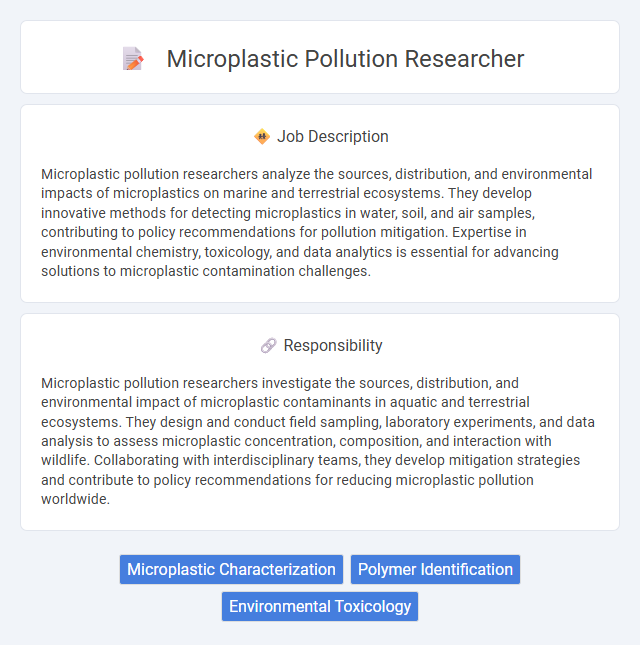
Microplastic pollution researchers analyze the sources, distribution, and environmental impacts of microplastics on marine and terrestrial ecosystems. They develop innovative methods for detecting microplastics in water, soil, and air samples, contributing to policy recommendations for pollution mitigation. Expertise in environmental chemistry, toxicology, and data analytics is essential for advancing solutions to microplastic contamination challenges.
Individuals with a strong interest in environmental science and a background in chemistry, biology, or environmental engineering are likely well-suited for a microplastic pollution researcher role. Those comfortable with laboratory work, field sampling, and data analysis may find this job fulfilling and manageable. People who prefer routine tasks or minimal field exposure might encounter challenges adapting to the dynamic and detail-oriented nature of this research.
Qualification
Candidates for a microplastic pollution researcher position typically require a strong background in environmental science, marine biology, or chemistry, with advanced degrees such as a Master's or PhD preferred. Expertise in analytical techniques like spectroscopy and chromatography for detecting microplastics in environmental samples is essential. Proficiency in data analysis, field sampling protocols, and knowledge of pollution mitigation strategies significantly enhance job performance in this specialized role.
Responsibility
Microplastic pollution researchers investigate the sources, distribution, and environmental impact of microplastic contaminants in aquatic and terrestrial ecosystems. They design and conduct field sampling, laboratory experiments, and data analysis to assess microplastic concentration, composition, and interaction with wildlife. Collaborating with interdisciplinary teams, they develop mitigation strategies and contribute to policy recommendations for reducing microplastic pollution worldwide.
Benefit
Microplastic pollution researchers likely gain benefits such as contributing to critical environmental protection efforts and influencing policy changes to reduce plastic waste. They probably experience professional growth through interdisciplinary collaboration and advanced scientific techniques. The role may offer job satisfaction linked to making a tangible impact on marine and terrestrial ecosystems.
Challenge
Microplastic pollution researcher positions likely present significant challenges due to the complexity of tracing microplastic sources and their environmental impacts. The role may require navigating limited data and emerging methodologies to accurately assess microplastic distribution and toxicity. Researchers probably face difficulties in securing funding and influencing policy amid evolving scientific understanding and public awareness.
Career Advancement
A microplastic pollution researcher explores the environmental impact of microscopic plastic particles, developing innovative methods for detection and mitigation. Career advancement in this field often involves progressing from research assistant roles to lead scientist or project manager positions, supported by publishing influential studies and securing research grants. Expertise in interdisciplinary collaboration with environmental agencies and industries enhances opportunities for leadership roles and policy advisory capacities.
Key Terms
Microplastic Characterization
Microplastic characterization researchers analyze the physical and chemical properties of microplastics in environmental samples, utilizing advanced spectroscopic and microscopic techniques such as FTIR, Raman spectroscopy, and scanning electron microscopy. They quantify microplastic size, shape, polymer composition, and surface morphology to understand environmental distribution and potential ecological impacts. Their work supports pollution mitigation strategies and informs regulatory policies targeting microplastic contamination in marine and terrestrial ecosystems.
Polymer Identification
Microplastic pollution researchers specializing in polymer identification utilize advanced spectroscopic techniques like Fourier-transform infrared (FTIR) spectroscopy and Raman spectroscopy to accurately classify microplastic particles in environmental samples. Their work enables the differentiation of polymer types such as polyethylene, polypropylene, and polystyrene, which is essential for understanding the sources and degradation pathways of microplastics. Precise polymer characterization supports targeted mitigation strategies and informs policy development to reduce microplastic contamination in aquatic and terrestrial ecosystems.
Environmental Toxicology
Microplastic pollution researchers specializing in Environmental Toxicology analyze the impact of microplastics on ecosystems and human health by studying their chemical composition, bioaccumulation, and toxic effects on aquatic organisms. These scientists employ advanced techniques such as mass spectrometry and molecular assays to identify microplastic contaminants and assess their interaction with environmental pollutants. Their work informs regulatory policies and remediation strategies aimed at reducing microplastic exposure and mitigating ecological risks.
 kuljobs.com
kuljobs.com